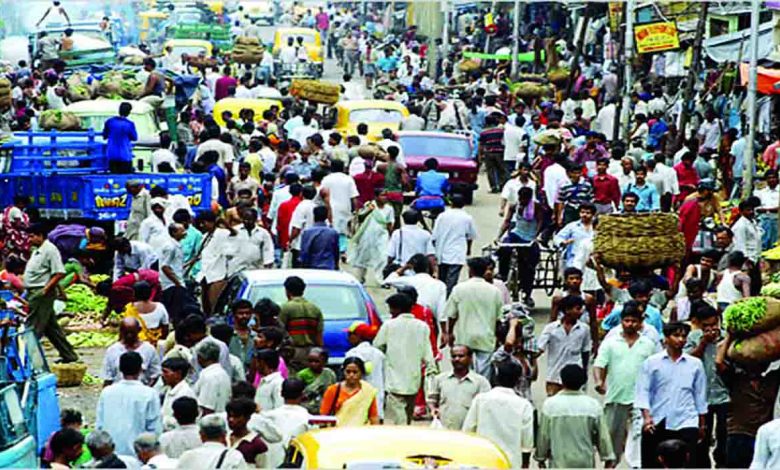Population and the future of India

Monday, 12 July 2021 | Vir Singh
GUEST COLUMN

The governance ‘philosophy’ aimed at appeasement of every society, class and sect and putting nationalism at the backseat is the biggest irony India has been experiencing since its independence. Governments, in fact, do not have the will to assess how the policies and strategies of appeasement are trampling the future of the country. There are innumerable concerns of various kinds in the public mind of the country, millions of minds are agitated over trifles, but they keep mum over the kind of future the country is going to usher in. The most formidable problem of our time is the population explosion, about which everyone is aware, but those who have the right to stop this explosion, close their eyes as soon as it comes to the discussion, like a pigeon on seeing a cat does.
The world population, as in March 2020, had reached 7,800,000,000. It took two million years in human prehistory and history for the world’s population to attain the one billion mark, but it took only 200 years to reach seven billion. After the Greater Famine of 1315 – 1317 and the “Black Death” in 1350, the world population was only about 370 million. In the last 770 years, the world population has increased from 370 million to around eight billion.
According to estimates by the United Nations Department of Economics and Social Affairs, by 2050 the world population will be nine to 10 billion and by the end of the 21st century it will rise to 10 to 12 billion. According to another demographic prediction, the world population will begin to decline in the second half of the 21st century. If this happens, it will be due to increased mortality owing to environmental adversities, climate change, hunger and pandemics worldwide.
So far, China is the most populous country in the world, whose total population has increased to 1,444,216,107 as on July 1 this year, according to the United Nations estimates. India is in second place with a total population of 1,391,942,558. By the year 2030, India will become a “world master” with a population of 1,528,000,000 leaving China behind. China’s population policy has been one of the most influential in Asia. China’s geographical area is three times more than India’s, yet India has beaten China in the ‘population war’. After effectively implementing the one-child policy for decades, China has now implemented a three-child policy after establishing its population balance. The success of China’s population policy is attributable to the uniform civil code that places a nation over and above all religions. On the contrary, it is certain that India will continue to beat China on the population front which is because of two reasons: lack of an effective population policy and no room for the uniform civil code in India’s Constitution.
There has been an outcry in the world regarding environmental pollution and consequent climate change. Our country has developed a new type of pollution—population pollution for which a new word has been coined in English: Popollution (population + pollution). It is only human species on Earth that creates environmental pollution. All other species and their populations contribute to maintain ecological balance. Thus, population explosion and environmental crises go hand in hand.
What can be most precious to the country, whose protection is the paramount duty of its government? Certainly the future of its generations. But the future of India has been affected by the present population explosion on the fertile ground of unequal civil code in its constitution. What will be the fate of the country whose governments do not have population control on the agenda and give more importance to the religious values than the future of the country?
On the basis of population growth rate, the countries of the world can be divided into three categories- countries with positive growth rate, countries with zero growth rate, and countries with negative growth rate. As many as 65 per cent of the world’s countries have a positive population rate, with Oman in the first place with 4.7 per cent growth rate and Bahrain, Nauru and Niger (all Islamic countries), with 4.6 per cent, 4.5 per cent and 3.8 per cent growth rates, are in second, third and fourth place respectively. Apart from these, in addition to India, there are Bangladesh, Pakistan, Iraq, Qatar, Afghanistan, Kuwait, Lebanon, Jordan, Palestine etc. consistently recording positive population growth rates. Countries with zero or fixed population rates are 24 per cent, the main ones being Sri Lanka, Myanmar, China, Thailand, UK, Denmark, Ireland, Cuba etc. Countries whose population is declining are only 11 per cent in the world, the main ones being Puerto Rico, Lithuania, Latvia, Bulgaria, Greece, Poland, Spain, Portugal, Italy, Moldova, Japan etc. In this way, we can see how poverty, unemployment, corruption (and even terrorism) are chasing the countries with growing populations, while socio-economic progress and prosperity are being followed by countries keeping the population stable or on the way to reduce it.
It is the dharma of the Constitution to ensure a healthy, secure and prosperous future to the country and to establish such laws and regulations so as to create an environment full of hope and peace and inspired by innovative creativity. Upholding those values which ensure the creation of such a future is the moral duty of a government. Since population explosion is threatening the future of the country, an effective population control law should be enacted at the earliest. To make it successful, the necessary Uniform Civil Code has to be incorporated in the Constitution.
(The author is a former professor of Environmental Science in GB Pant University of Agriculture and Technology. Views expressed are personal)






